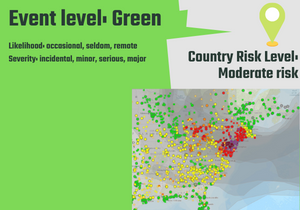
El humo de los incendios forestales en Canadá está causando actualmente una mala calidad del aire en varias partes de la costa este de Estados Unidos. La situación hace que las autoridades estadounidenses hayan emitido una serie de recomendaciones para que la población se proteja.
Entre las medidas recomendadas, se encuentra la de consultar AirNow.gov para obtener actualizaciones sobre la calidad actual del aire en su ubicación. Asimismo, se recomienda seguir los consejos dados por las autoridades estadounidenses, que incluyen el uso de una mascarilla. Los viajes aéreos también pueden verse interrumpidos debido al humo de los incendios forestales en Canadá. Por lo tanto, se aconseja que antes de viajar, se verifique el estado de su vuelo con su aerolínea.
La situación es particularmente preocupante para las personas que sufren de problemas respiratorios, ya que el humo de los incendios forestales puede ser perjudicial para su salud. Asimismo, se recomienda que las personas con problemas de salud crónicos estén en alerta y sigan las recomendaciones de las autoridades.
Debido al problema de calidad del aire que afecta a la parte noreste de los Estados Unidos, algunas aerolíneas han decidido flexibilizar las condiciones de las tarifas. Los aeropuertos afectados incluyen Akron Canton, OH (CAK), Albany Intl, NY (ALB), Allentown Bethlehem, PA (ABE), Baltimore Washington, MD (BWI), Boston, MA (BOS), Buffalo, NY (BUF), Charlottesville, VA (CHO), Cleveland, OH (CLE), Columbus, OH (CMH), Manchester, NH (MHT), New York JFK, NY (JFK), New York LGA, NY (LGA), Newark, NJ (EWR), Newport News, VA (PHF), Norfolk, VA (ORF), Philadelphia, PA (PHL), Providence, RI (PVD), Richmond, VA (RIC), Rochester, NY (ROC), Salisbury, MD (SBY), Scranton Wilkes-Barre, PA (AVP), Syracuse, NY (SYR), Washington Dulles, DC (IAD), Washington Reagan, DC (DCA), Westchester County, NY (HPN), Worcester, MA (ORH), Bangor, ME (BGR), Charleston, WV (CRW), Cincinnati, OH (CVG), Dayton, OH (DAY), Detroit Metro, MI (DTW), Erie, PA (ERI), Flint, MI (FNT), Grand Rapids, MI (GRR), Harrisburg Intl, PA (MDT), Hartford Springfield, CT (BDL), Huntington, WV (HTS), Kalamazoo, MI (AZO), Lansing, MI (LAN), Lynchburg, VA (LYH), Montreal, Canadá (YUL), Pittsburgh, PA (PIT), Quebec, Canadá (YQB), Roanoke, VA (ROA), South Bend, IN (SBN), Toronto, Canadá (YYZ) y Watertown, NY (ART).
Desde el pasado mes de mayo, las autoridades de Canadá se encuentran en alerta debido a los incendios forestales que han afectado a varias provincias del país, entre las que se encuentran Quebec, Alberta y Nueva Escocia. La situación ha sido tan grave que se ha activado el Mecanismo de Protección Civil de la Unión Europea para solicitar asistencia internacional y hacer frente a la emergencia.
Hasta el momento, se estima que la superficie afectada por los incendios supera los 4 millones de hectáreas, lo que ha generado una gran preocupación no solo para las autoridades canadienses, sino también para los países vecinos, como Estados Unidos, ya que el humo generado por los incendios se está extendiendo a varios estados del noreste y este del país.
United States: Smoke from wildfires in Canada affects air quality on the East Coast.
The smoke from forest fires in Canada is currently causing poor air quality in several parts of the east coast of the United States. The situation has prompted the US authorities to issue a series of recommendations for the public to protect themselves.
Among the recommended measures is to check AirNow.gov for updates on the current air quality in your location. It is also recommended to follow the advice given by the US authorities, which includes the use of a respirator. Air travel may also be disrupted due to smoke from wildfires in Canada. Therefore, it is advised that before travelling, you check the status of your flight with your airline.
The situation is of particular concern for people suffering from respiratory problems, as smoke from the forest fires can be detrimental to their health. It is also recommended that people with chronic health problems be alert and follow the recommendations of the authorities.
Due to the air quality problem affecting the northeastern part of the United States, some airlines have decided to relax fare conditions. Airports affected include Akron Canton, OH (CAK), Albany Intl, NY (ALB), Allentown Bethlehem, PA (ABE), Baltimore Washington, MD (BWI), Boston, MA (BOS), Buffalo, NY (BUF), Charlottesville, VA (CHO), Cleveland, OH (CLE), Columbus, OH (CMH), Manchester, NH (MHT), New York JFK, NY (JFK), New York LGA, NY (LGA), Newark, NJ (EWR), Newport News, VA (PHF), Norfolk, VA (ORF), Philadelphia, PA (PHL), Providence, RI (PVD), Richmond, VA (RIC), Rochester, NY (ROC), Salisbury, MD (SBY), Scranton Wilkes-Barre, PA (AVP), Syracuse, NY (SYR), Washington Dulles, DC (IAD), Washington Reagan, DC (DCA), Westchester County, NY (HPN), Worcester, MA (ORH), Bangor, ME (BGR), Charleston, WV (CRW), Cincinnati, OH (CVG), Dayton, OH (DAY), Detroit Metro, MI (DTW), Erie, PA (ERI), Flint, MI (FNT), Grand Rapids, MI (GRR), Harrisburg Intl, PA (MDT), Hartford Springfield, CT (BDL), Huntington, WV (HTS), Kalamazoo, MI (AZO), Lansing, MI (LAN), Lynchburg, VA (LYH), Montreal, Canada (YUL), Pittsburgh, PA (PIT), Quebec, Canada (YQB), Roanoke, VA (ROA), South Bend, IN (SBN), Toronto, Canada (YYZ) and Watertown, NY (ART).
Since last May, the Canadian authorities have been on alert due to forest fires that have affected several Canadian provinces, including Quebec, Alberta and Nova Scotia. The situation has been so serious that the European Union’s Civil Protection Mechanism has been activated to request international assistance to deal with the emergency.
So far, the area affected by the fires is estimated to be more than 4 million hectares, which has generated great concern not only for the Canadian authorities, but also for neighbouring countries, such as the United States, as the smoke generated by the fires is spreading to several states in the north-east and east of the country.
